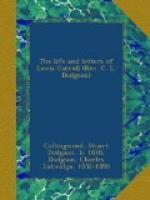During the Long Vacation he spent a few weeks in the English Lake District. In spite of the rain, of which he had his full share, he managed to see a good deal of the best scenery, and made the ascent of Gable in the face of an icy gale, which laid him up with neuralgia for some days. He and his companions returned to Croft by way of Barnard Castle, as he narrates in his Diary:—
We set out by coach
for Barnard Castle at about seven, and
passed over about forty miles
of the dreariest hill-country
I ever saw; the climax of
wretchedness was reached in Bowes,
where yet stands the original
of “Dotheboys Hall”; it has
long ceased to be used as
a school, and is falling into
ruin, in which the whole place
seems to be following its
example—the roofs
are falling in, and the windows broken or
barricaded—the
whole town looks plague-stricken. The
courtyard of the inn we stopped
at was grown over with
weeds, and a mouthing idiot
lolled against the corner of the
house, like the evil genius
of the spot. Next to a prison or
a lunatic asylum, preserve
me from living at Bowes!
Although he was anything but a sportsman, he was interested in the subject of betting, from a mathematical standpoint solely, and in 1857 he sent a letter to Bell’s Life, explaining a method by which a betting man might ensure winning over any race. The system was either to back every horse, or to lay against every horse, according to the way the odds added up. He showed his scheme to a sporting friend, who remarked, “An excellent system, and you’re bound to win—if only you can get people to take your bets.”
In the same year he made the acquaintance of Tennyson, whose writings he had long intensely admired. He thus describes the poet’s appearance:—
A strange shaggy-looking man; his hair, moustache, and beard looked wild and neglected; these very much hid the character of the face. He was dressed in a loosely fitting morning coat, common grey flannel waistcoat and trousers, and a carelessly tied black silk neckerchief. His hair is black; I think the eyes too; they are keen and restless—nose aquiline—forehead high and broad—both face and head are fine and manly. His manner was kind and friendly from the first; there is a dry lurking humour in his style of talking.
I took the opportunity [he
goes on to say] of asking the
meaning of two passages in
his poems, which have always
puzzled me: one in “Maud”—
Strange that I
hear two men
Somewhere
talking of me;
Well, if it prove
a girl, my boy
Will
have plenty; so let it be.
He said it referred to Maud,
and to the two fathers
arranging a match between
himself and her.
The other was of the poet—
Dowered with the
hate of hate, the scorn of scorn,
The
love of love.




